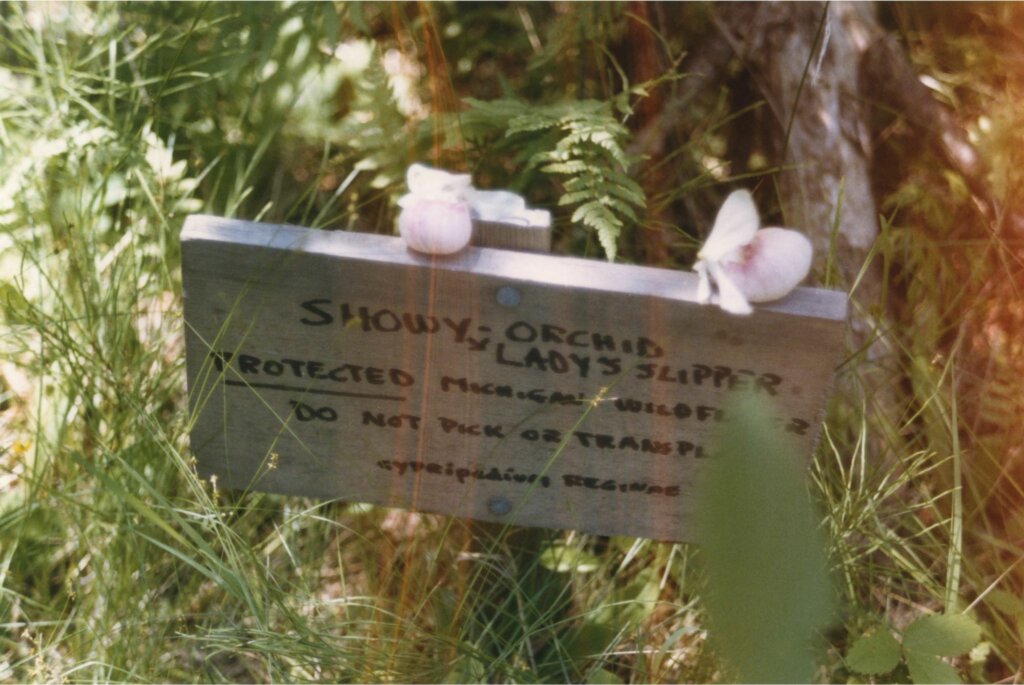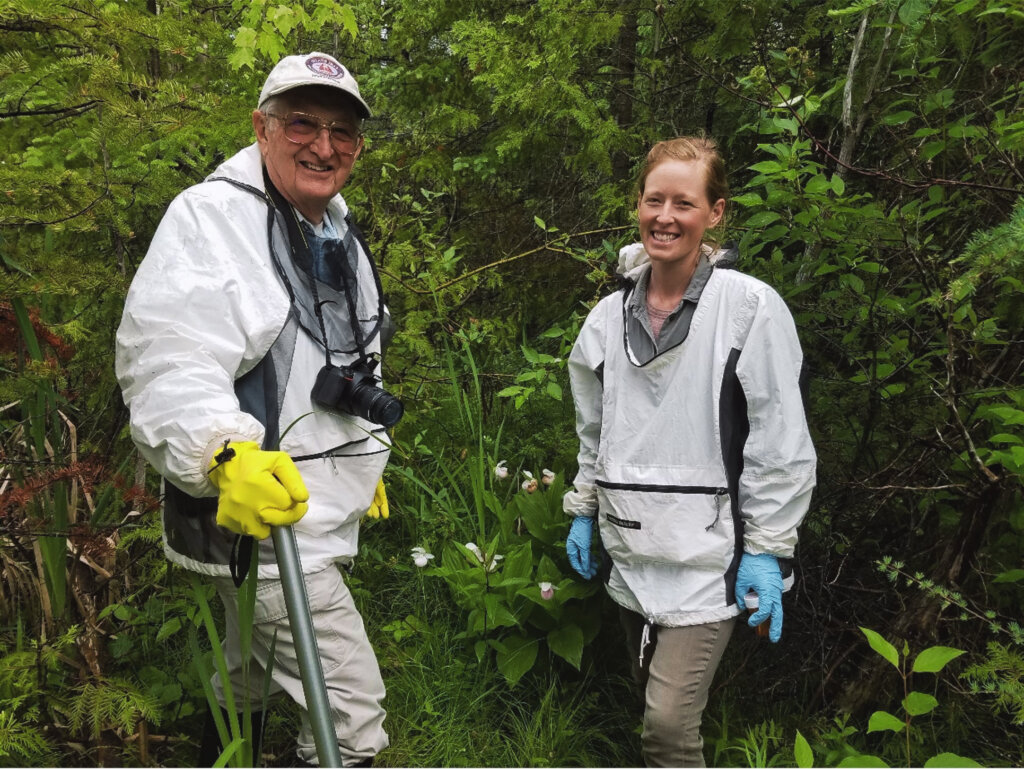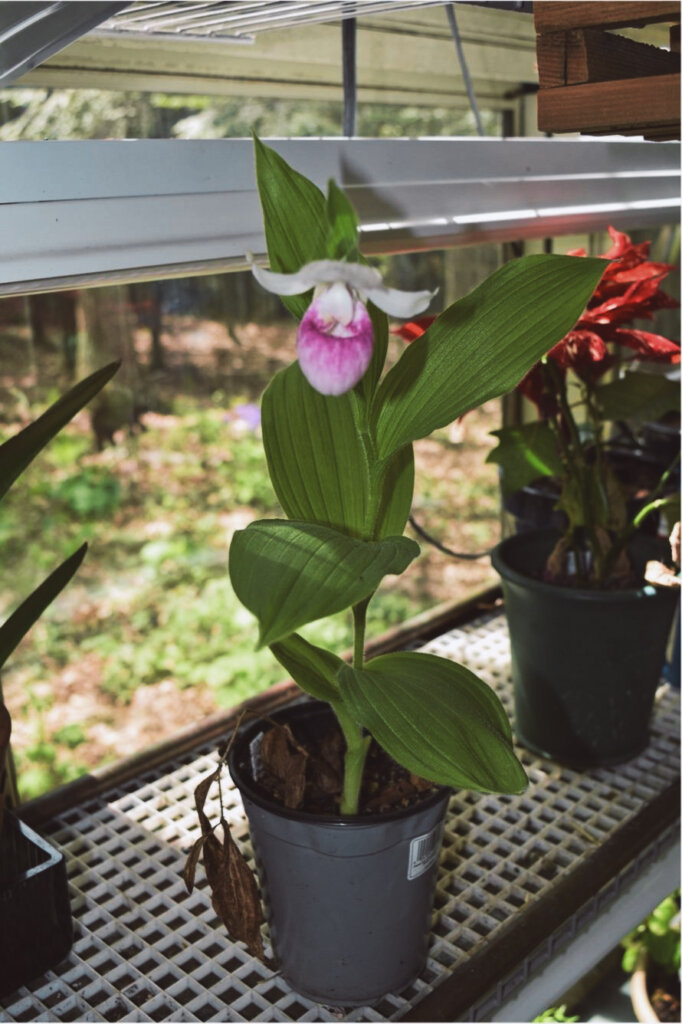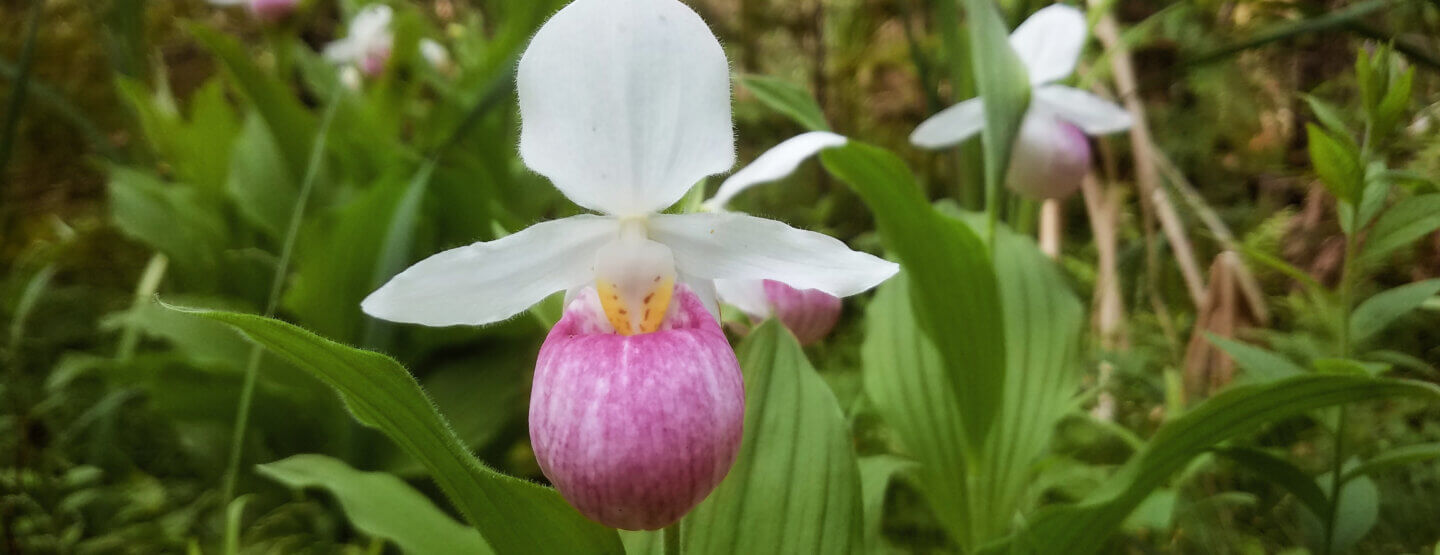Their finicky nature and breathtaking beauty make orchids some of nature’s most admired flowers. The orchids that might come to mind are the ones we see in markets and are of exotic varieties from Asia, Australia, the Himalayas, and the Philippines. To find an orchid growing wild is to see it at its most beautiful. Juxtaposed against dark soil and fallen leaves, it is a genuine diamond in the rough.
Spotting a wild orchid holds enough star power to make any naturalist stop in their tracks. An entire woodland field is a lifetime memory and rare sight. Soper Natural Area was once home to lots of Showy Lady Slipper orchids. The natural area was protected by the Leelanau Conservancy in 1991. In 2008 an additional 38 acres were added. It was around that time that LC members Chuck and Janet Dickerson began to hatch an extended and steadfast plan to restore the Showy Lady Slippers at Soper, or as Chuck calls it, “the Queen’s Garden.”

Soper’s namesake and first 42 acres came from Edna and James C. Soper. She donated the property to the Conservancy in honor of her late husband and with hopes of preserving the stunning 1,000 or more Showy Lady Slipper orchids that grew there. However, the number of increasing orchids began to dwindle with each passing year, and by 2002, only six bloomed. Plenty of factors have impacted their shrinking numbers. “They can get tall, around hip height. And their color is a beautiful pink that melts into white,” said Land Steward Emily Douglas. “They have really robust leaf structures to them, so they look like a hardy flower, but they’re not. A big reason we’ve lost so many is because of people poaching them. Deer browse is huge, too. They treat it like candy and just pulverize them. There could also be environmental factors going on like the canopy changing, the water table changing.”
Janet and Chuck agree that the water table has lowered over the years. The water table is the groundwater that saturates the soil, bedrock, and clay-like regolith beneath the soil surface. Groundwater travels underground in paths that sometimes turn into lakes, ponds, and marshes when land’s surface submerges below the water table. Intermittent periods of drought have impacted the marsh-like quality Showy Lady Slippers thrive in.
Chuck grew up visiting Leelanau. His parents built a cottage in Omena during the ‘60s, and the family would drive up from St Louis, Missouri, every summer. When Chuck and Janet married, they started a family and brought their kids up from St Louis to do the same. In 1999, Chuck and Janet retired here and live a stone’s throw away from the family cottage.
A camera purchased by Janet’s dad introduced them to Soper’s Showy Lady Slippers. “She was busy with the children, and I had the camera. There are so many beautiful views in the county,” Chuck said. “Up in Northport, there was a swamp that I started going to in the ‘70s or early ‘80s. You hardly had to get your feet wet to get pictures of these Showy Lady Slippers.”
When the Conservancy acquired Soper, it was a popular destination for its view of Showy Lady Slippers. Back then, they were accessible to see up close by a boardwalk in James Soper’s honor. After a mass of Showy Lady Slippers were poached in 2002, the Conservancy removed the boardwalk and access to ecologically sensitive portions of the property.

Chuck, Janet, and Emily got to work with a restoration plan intact. Creating the deer exclosures to protect what Showy Lady Slippers were left came first. Genetic material was taken from two different orchid varieties in the county. These parent genetics come from seedpods of Showy Lady Slippers from an easement adjacent to Soper and a population growing roadside on North Lake Leelanau Drive. “Being roadside, salt and plow are part of their environment, so they looked hardy,” Emily explained. This duo of orchid genetic material was chosen in hopes of creating a stronger varietal that can repopulate what has been lost at Soper.

Chuck pollinated the samples and sent them to a specialty orchid grower in Wisconsin who sowed the seeds and sent back protocorms. A protocorm is a tiny orchid seedling with a good root structure. The ones sent back to Chuck are the offspring of the two collected wild orchids. “They’re so super tiny they look like spiders. The Wisconsin grower, Scott Weber, specializes in orchid seeds and sent 700 of these to Chuck,” Emily said. “Chuck took them and grew them for over six years.”

Showy Lady Slippers are federally listed as endangered. Their beauty, required living conditions, and complex reproductive qualities make them prone to decline. Orchids grow where they can. They need a special kind of fungus, called mycorrhizal fungi, in their soil to grow. Unlike most seeds that are equipped to nourish themselves for a time, orchid seeds have to lure fungi into feeding them until they begin to sprout and start photosynthesizing on their own. Orchids don’t want to compete with other plants for water, nutrients, and sunlight. Instead of selecting areas with rich soil, they choose more inhospitable conditions like bedrock or swamp. The Showy Lady Slippers of Soper like streaky sunlight and damp soil.

In 2011, Chuck and Janet received the 700 orchid protocorms to which they would become caretakers. They painstakingly cultivated the ideal growing conditions for Showy Lady Slippers year-round. “We put them outside in the summer and into a refrigerator during the winter. We don’t want them to freeze off,” said Chuck. “When they’re six years old, we put them in a seed starter with heat before April when we put them back outside in their critter-proof enclosures. They stay out there until winter, and then the whole process starts over again.” Out of the 700 plants, 70 survived. In 2017 those Showy Lady Slippers were planted back into the wild at Soper and in other Leelanau locations where it’s believed they will thrive. So far, things are going well. One site had all five of their new Showy Lady Slippers bloom this past summer.
It’s roughly a decade-long journey for orchids to get from seed to flower. Because of this, the restoration project at Soper is an ongoing one. “Most ecological projects should be long-running,” said Emily. “You’re working at the pace of nature.” Right now, Chuck, Emily, Director of Natural Areas and Preserves Becky Hill, and Conservation Easement Program Manager Chase Heise all have a fresh batch of growing orchid seedlings that they received in June of last year. Towards the end of the 2020s, we’ll have even more Showy Lady Slippers to place back in Soper and beyond in Leelanau. Chuck and Janet hope that the project grows more with time.

The Dickersons look forward to this resurgence of native beauty. They would like to grow a community of volunteers interested in becoming caretakers to some of these Showy Lady Slippers. They have to be babied with rainwater, enclosures, and a seasonal schedule, but Chuck believes folks out there would enjoy getting involved. “It’s an unusual Conservancy project because people don’t get to really see it,” Chuck said. “But it’s exceptional work that we hope continues long past us.” When asked why they’ve dedicated themselves so passionately to a project that’s fruits they may never see, the couple agrees that the journey has been just as remarkable as the outcome. “It’s about the impact that it makes,” said Janet. “You never know who you influence or how deep it goes.”




